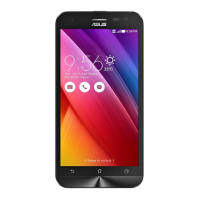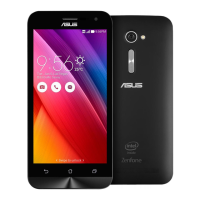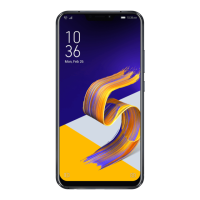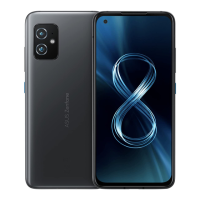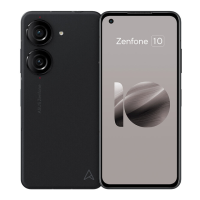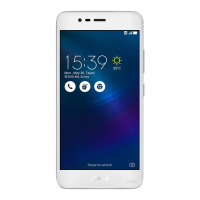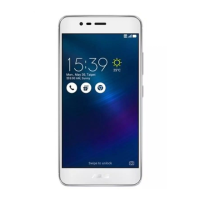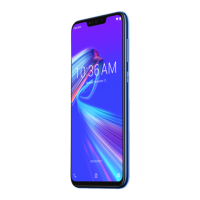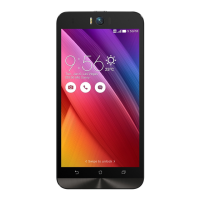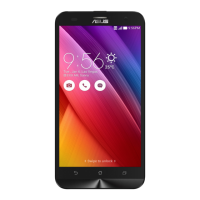Do you have a question about the Asus ZENFONE2 ZE500KL and is the answer not in the manual?
Important safety instructions for using the device in various environments and conditions.
Introduction to the ASUS Zen UI 2.0 and its core benefits for users.
Guide to unpacking and preparing your ASUS Phone for initial use.
Steps for the initial setup and configuration of your new ASUS Phone.
Explanation of touchscreen gestures for navigation and interaction with the device.
Overview of the Home screen's functionalities and notification displays.
Customizing the Home screen with wallpapers, app shortcuts, and widgets.
Settings and customization options for the device's lock screen.
Instructions for using the web browser, including tabs and bookmarks.
Setting up and managing email accounts on your ASUS Phone.
Managing events, setting reminders, and syncing calendar accounts.
Viewing upcoming events and notifications at a glance.
Organizing tasks, calls, and messages for later action.
Creating and managing notes, including cloud syncing.
Accessing and managing files on internal and external storage.
Information on cloud storage services like ASUS WebStorage.
Transferring data between devices using Bluetooth technology.
Accessing support, FAQs, and solutions for ZenUI apps.
Managing Dual SIM features and call settings.
Instructions on how to make calls using various methods.
Handling incoming calls, answering, and setting callbacks.
Viewing and managing call history, blocking numbers, and saving contacts.
Exploring features like microphone, speakerphone, call hold, and recording.
Handling multiple calls simultaneously and setting up conference calls.
Instructions on how to record phone calls for future reference.
Organizing contacts, setting up profiles, and managing groups.
Adding new contacts and managing contact information.
Editing contact details, adding photos, and setting ringtones.
Grouping contacts as VIPs for special notifications and alerts.
Setting frequently called contacts as favorites for quick access.
Importing contact data from various sources like SIM or storage.
Exporting contact data to storage accounts or SIM cards.
Blocking or unblocking unwanted contacts and numbers.
Integrating social network accounts to view contact profiles and feeds.
Manually linking and unifying contact information from multiple sources.
Creating backups and restoring call log history.
Configuring call settings like blocking, forwarding, and ringtones.
Managing SMS messages, including sending, replying, and blocking.
Detailed guide on using the messaging application.
Steps to block spam and unwanted messages.
How to forward message conversations to others.
Setting messages as reply-later tasks for convenient follow-up.
Additional options for composing and managing messages.
Using the Omlet Chat app for messaging and sharing.
Sending text, voice messages, and stickers within Omlet Chat.
Creating and joining social hotspots for group chats.
Accessing photos shared within Omlet Chat via the Gallery app.
Viewing all photos shared by contacts in the Gallery.
Viewing photos shared within specific chat rooms.
Viewing photos shared by individual contacts.
Accessing Omlet contacts through the main Contacts app.
Syncing Omlet Chat data with cloud storage services.
Connecting and using a headset for calls and music playback.
Launching the Music app and playing songs from various sources.
Additional music playback controls like adding to playlists and sharing.
Accessing and streaming music from cloud storage accounts.
Detailed steps for streaming music from your cloud account.
Organizing favorite songs into playlists from different sources.
Adding multiple songs to an existing playlist.
Streaming media from your phone to compatible devices.
Listening to local radio stations using the FM Radio app.
Overview of launching the Camera app from various access points.
Initial setup guide for the Camera app, including tutorial and photo locations.
Understanding the camera interface and its main icons.
Adjusting camera settings for image quality and appearance.
Configuring shutter speed, timer, and burst modes.
Enabling touch auto-exposure and face detection.
Adjusting camera settings for video recording quality.
Exploring enhanced camera modes like Low light, HDR, and Panorama.
Reviewing and saving photos captured with the Time Rewind feature.
Capturing high-dynamic-range photos for challenging lighting conditions.
Creating wide-angle panoramic photos by stitching images.
Taking well-lit photos in low-light or nighttime conditions.
Capturing selfies and group selfies using face detection.
Applying a tilt-shift effect for a miniature photography look.
Eliminating unwanted objects from photos after capture.
Capturing a sequence of photos to find the best facial expression.
Applying live beauty enhancements to faces in photos.
Creating animated GIF images directly from the camera.
Recording videos with a time-lapse effect for fast-forward playback.
Viewing, editing, and managing photos and videos in the Gallery app.
Accessing media files stored on social networks or cloud services.
Viewing location details and maps for photos taken.
Sharing selected photos and videos from the Gallery.
Removing unwanted photos and videos from the Gallery.
Using the Gallery's built-in tools to enhance images.
Integrating photos with Calendar events for viewing.
Creating slideshows from photos using the MiniMovie feature.
Streaming media files to compatible devices using PlayTo.
Enabling and configuring mobile network data access for internet.
Connecting to Wi-Fi networks for internet access and data exchange.
Using Bluetooth for wireless file transfer and media streaming.
Using the phone as a modem or Wi-Fi hotspot.
Getting real-time weather updates and forecasts.
Customizing time zones, setting alarms, and using clock features.
Setting and managing alarms on your ASUS Phone.
Using the phone's stopwatch functionality for timing.
Setting and using multiple timer options on your device.
Overview of ZenLink apps for productivity and file sharing.
Creating and joining virtual groups for real-time photo sharing.
Sharing files, apps, and media with other Android devices.
Accessing and controlling your phone from a computer.
Using the phone as a wireless input device and presentation tool.
Utilities like Flashlight, Calculator, and Quick memo.
Using the phone's LED flash as a flashlight and SOS signal.
Using the built-in calculator for computations.
Creating quick notes and turning them into sticky notes.
Recording audio files and managing recordings.
Customizing sound modes for optimal audio output.
Adjusting display settings for color and visual experience.
Optimizing and extending battery life with power saving modes.
Information about additional accessories like the ASUS Cover.
Installing and configuring settings for the ASUS Cover accessory.
Updating system software and managing device storage and backups.
Using security features to protect your device and data.
Setting up a PIN code for screen lock security.
Creating a pattern for screen lock security.
Setting up a password for screen lock security.
Customizing quick access, widgets, and camera on the lock screen.
Finding your device's serial number, IMEI, and model information.
General regulatory and compliance information for the device.
FCC compliance statement and operating conditions.
Device compliance with radio frequency exposure limits.
Canadian regulatory compliance and warnings.
Product compliance with EU regulations.
Safety guidelines to prevent hearing damage from audio playback.
Requirements for power cords and electrical safety.
Information on product recycling and environmental responsibility.
Details on protective coating for electrical safety.
Information on ASUS's environmental initiatives.
Product compliance with Singapore IDA Standards.
| Display Size | 5.0 inches |
|---|---|
| Resolution | 720 x 1280 pixels |
| Processor | Qualcomm MSM8916 Snapdragon 410 |
| RAM | 2 GB |
| Internal Storage | 16 GB |
| Main Camera | 8 MP |
| Front Camera | 2 MP |
| Battery Capacity | 2500 mAh |
| Battery Type | Li-Po |
| Operating System | Android 5.0 (Lollipop), upgradable to 6.0 (Marshmallow) |
| SIM | Dual SIM (Micro-SIM, dual stand-by) |
| Weight | 140 g (4.94 oz) |
| Expandable Storage | microSD |
| Dimensions | 148.1 x 71.5 x 10.9 mm |
| Colors | Red, White, Gold |
